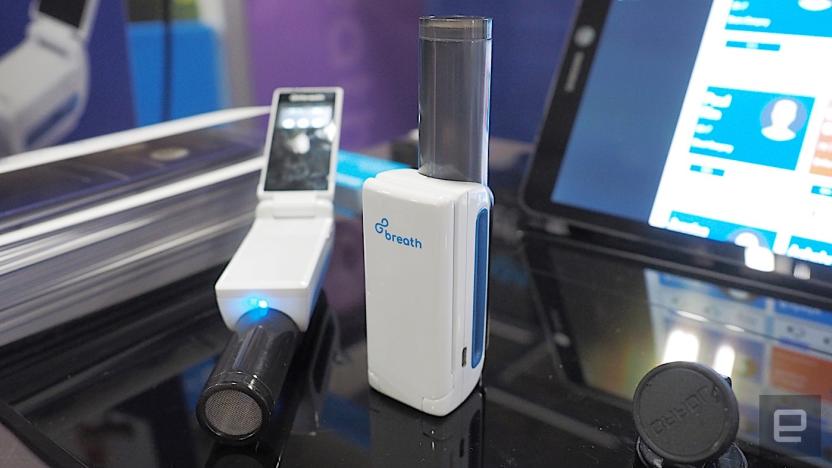asthma
Latest

Apple reportedly buys asthma-monitoring startup
Apple has snapped up a company called Tueo Health, which was working on an app to help parents monitor asthma symptoms of their sleeping kids, according to CNBC. The startup's CEO and chief operating officer switched their employer to Apple on LinkedIn late last year, which is when the deal seems to have closed. Apple declined to comment to Engadget on the report.

GoBreath makes fixing your lung capacity fun
If you have issues with breathing after chest trauma, surgery or anesthesia, then there are breathing exercises designed to help. Normally, your ability to breathe is calculated by using a spirometer, which isn't that interactive -- or accurate. That's what prompted a team of Korean designers to begin working on GoBreath, a digital spirometer that tries to make breathing exercises fun. It's another one of Samsung's C-Lab projects to try and spin out neat product ideas from the Korean behemoth.

CES 2015: ADAM wearable monitors asthma via app
According to the Centers for Disease Control and Prevention, asthma affects over 25 million adults and children in the US alone, and is responsible for 14.2 million physician visits each year as well as 1.8 million emergency care visits. With that huge - and growing - population of asthma sufferers and the associated costs of treating the disease, monitoring and managing asthma is quickly becoming a necessity. Health Care Originals highlighted its ADAM (Asthma Detection And Monitoring) wearable and app at CES 2015, a system designed to detect symptoms of asthma, provide alerts, and more. ADAM uses a small wearable patch to detect coughs, monitor respiration and heart rate, and listen for wheezing. The device and app are expected to ship in the second quarter of 2015. By that time it's expected that the sensor will also be able to monitor inhaler use, provide alerts of impending asthma attacks, let patients forward those alerts to their primary care physician or specialist, track and trend symptoms, and even provide treatment plans. Need a reminder to use your inhaler or take other prescribed medication? The ADAM app will provide you with reminders. All data that is generated by the sensor and captured by the app is kept in HIPAA-compliant storage, and the company is looking into integration with HealthKit as well. ADAM is yet another example of how app-connected devices are beginning to revolutionize health care, hopefully reducing both patient visits and the cost of treatment.

Spiroscout inhaler uses GPS, WiFi to track asthma attacks
Back in 2009, we told you about a University of Wisconsin-Madison scientist using GPS to tag asthmatics in an effort to better understand what was triggering their attacks. Two years later, David Van Sickle and his current company, Asthmapolis, are about ready to turn his research into a commercial product dubbed the Spiroscout. The USB-powered inhaler uses GPS as well as WiFI to track patients' inhaler use, which Van Sickle says will yield a fuller, more accurate body of data than the self-recorded logs patients are often asked to keep. The benefit is two-fold, Van Sickle says: physicians can use this data to adjust their patients' medication, if necessary, while epidemiologists might have more insight into population-level trends. As PhysOrg notes, this isn't the first inhaler of its kind (incidentally, that would be Asthmapolis' first-gen product, the SiliconSky GPS), but it may be the most practical one to date in that it doesn't come with a bulky box attached. Spiroscout isn't available just yet -- the company expects it to ship in the fall -- but curious asthmatics can reserve theirs now.

Siemens creating portable sensor to warn about asthma attacks, breathe deeply until it ships
We all wheeze a little from time to time, at least we do when we've fallen off the fitness wagon and are trying desperately to climb back on. For some it's a little more serious than that, and for those prone to dangerous bouts of asthma Siemens AG has a bit of hope. It's developed a portable sensor that can detect minute increases of nitric oxide in a patient's breath, particles that serve as a sign of an impending asthma attack. The user can then use that information to ingest the correct amount of anti-inflammatory meds. The device is said to be about the size of a cellphone, though unfortunately Siemens didn't specify a model. Like, are we talking a Veer here or a king-sized Nexus S? Inquiring minds want to know.

Researcher plans to use GPS to study asthma triggers
You wouldn't expect GPS tech to have an impact on asthma research, but the University of Wisconsin-Madison's David Van Sickle says it will -- he's planning on tagging sufferers so he can learn when and where they reach for their inhalers. The data will hopefully make sorting out environmental triggers of the disease much easier -- it took scientists eight years to prove that soybean dust near the Barcelona harbor caused a massive asthma outbreak in the 80s, a timeline that might have been dramatically shorter if location information had been available from the start. The plan's still in the early stages, but would-be participants can sign up already -- let's just hope the tracker is slightly more attractive than Kogan's enormous watch unit.[Via CNET]

Pocketable gas sensor aims to better understand asthma
Sure, we've got fairly sophisticated methods of curbing asthma attacks, but a new pocketable device could hold the key to unlocking more about the relationship between "asthma symptoms and the air a sufferer breathes." Reportedly, this device could allow researchers to look back after an attack has occurred and see exactly what was happening environmentally beforehand. Gurus at the Georgia Tech Research Institute have already been able to help one individual out, as they discovered a "pollutant pathway" from the volunteer's basement into the living room that was allowing vehicle exhaust and gasoline fumes to infiltrate the house. From here, the creators are hoping to downsize the device even further and make it more sensitive, but we've no idea if the current iteration will ever be used commercially.[Via NewScientist]

Virtually Overlooked: Bronkie the Bronchiasaurus
Welcome to our weekly feature, Virtually Overlooked, wherein we talk about games that aren't on the Virtual Console yet, but should be. Call it a retro-speculative. Some of the games we cover in this feature are worth talking about just because of their concepts. Zombie Nation, about a giant flying head, for example. Bronkie the Bronchiasaurus might be the ultimate conceptually-interesting game, at least to us, since it is one of the most bizarre and incongruous things ever to appear on a console. Bronkie is an educational side-scrolling platformer for the SNES about an anthropomorphic dinosaur with asthma.

Radiofrequency treatment curbs asthma attacks
Sure, there's quite a few way to circumvent the effects of asthma, but a new development coming out of McMaster University in Canada suggests that radiofrequency treatment can actually curb the amount of asthma attacks suffered by asthmatics. The device, which "uses radio waves to heat the muscle lining of patients' airways," is used to administer a trio of sessions, and while the actual root cause is still unknown, it seems to cause a reduction in the smooth muscle lining the airways, subsequently making breathing less of a chore. The probe isn't the most comfortable, however, as it must first make its way through your nose or mouth in order to reach the lung airways, after which the tip is "heated using radio waves." The procedure is known as bronchial thermoplasty, and while the funding company (Asthmatx) has yet to elicit a thumbs-up from the FDA, it could certainly become a viable alternative for asthma sufferers. It's about time these free-flying transmissions made up for the harm they've caused, eh?

MediDive's Asthma Freedom Snorkle
Australian company MediDive has created what it claims to be the world's first snorkle for asthmatics, finally giving those suffering from asthma the ability to go on daring diving expiditions with their local Team Zissou. MediDive's solution isn't the most complicated one, but it should get the job done. Before getting suited up for a dive, you simply remove the Metered Dose Inhaler canister from your regular asthma inhaler and insert it into the specially-designed compartment in the Asthma Freedom Snorkle; then, when you need a dose of medication, you simply use the snorkle as you would your usual asthma inhaler. Other more snorkle-oriented features include a purge valve to clear out water, a flex tube section for enhanced comfort, and an interchangeable silicon mouthpiece -- red cap not included. No word on price or compatibility with whippits, but it looks to only be available in Australia and New Zealand for the time being.[Via Crave]







